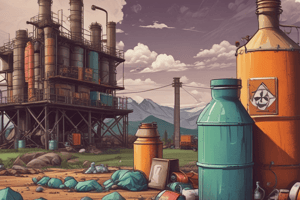Podcast
Questions and Answers
What must a substance be refined from to meet the EPA’s definition of used oil?
What must a substance be refined from to meet the EPA’s definition of used oil?
- Unrefined petroleum
- Crude oil or synthetic materials (correct)
- Vegetable oil
- Animal fats
Which of the following does NOT meet the EPA’s definition of used oil?
Which of the following does NOT meet the EPA’s definition of used oil?
- Hydraulic fluids that are contaminated
- Bottom clean-out waste from virgin fuel storage tanks (correct)
- Lubricants that have been used
- Heat transfer fluids that have been used
Which contaminants can affect the classification of used oil?
Which contaminants can affect the classification of used oil?
- Exclusively physical contaminants
- Only biological pathogens
- Only chemical additives
- Physical or chemical impurities (correct)
What is the minimum percentage of a tank's volume that must be underground to be classified as an underground storage tank (UST)?
What is the minimum percentage of a tank's volume that must be underground to be classified as an underground storage tank (UST)?
Which of the following could be considered a physical contaminant in used oil?
Which of the following could be considered a physical contaminant in used oil?
What is rusting primarily a result of?
What is rusting primarily a result of?
Which act regulates hazardous waste from generation to disposal?
Which act regulates hazardous waste from generation to disposal?
What does thermal decomposition of materials often produce?
What does thermal decomposition of materials often produce?
What is the primary focus of the Comprehensive Environmental Response, Compensation, and Liability Act (CERCLA)?
What is the primary focus of the Comprehensive Environmental Response, Compensation, and Liability Act (CERCLA)?
What can water-sensitive chemicals react with that may result in extreme heats?
What can water-sensitive chemicals react with that may result in extreme heats?
Which act established a trust fund for cleanup at hazardous waste sites when no responsible party can be identified?
Which act established a trust fund for cleanup at hazardous waste sites when no responsible party can be identified?
What was one of the key updates provided by the Superfund Amendment and Reauthorization Act (SARA)?
What was one of the key updates provided by the Superfund Amendment and Reauthorization Act (SARA)?
Which aspect is NOT involved in planning and organization?
Which aspect is NOT involved in planning and organization?
What is a key component of site safety planning?
What is a key component of site safety planning?
Which of the following is included in the medical program?
Which of the following is included in the medical program?
Who should be restricted from site entry during the onsite surveys?
Who should be restricted from site entry during the onsite surveys?
What is the purpose of ongoing monitoring at a site?
What is the purpose of ongoing monitoring at a site?
What should be developed based on the specific needs of employees at a site?
What should be developed based on the specific needs of employees at a site?
What is NOT a part of handling emergencies in site safety planning?
What is NOT a part of handling emergencies in site safety planning?
Which of the following is included in surveillance under the medical program?
Which of the following is included in surveillance under the medical program?
Which option involves the storage and transportation of hazardous materials?
Which option involves the storage and transportation of hazardous materials?
What is the maximum time generators can accumulate hazardous waste without needing a permit?
What is the maximum time generators can accumulate hazardous waste without needing a permit?
Which of the following is a characteristic of corrosive waste?
Which of the following is a characteristic of corrosive waste?
What type of hazardous waste can pose a threat even when managed properly?
What type of hazardous waste can pose a threat even when managed properly?
What do Land Disposal Restrictions (LDRs) prohibit?
What do Land Disposal Restrictions (LDRs) prohibit?
What must agricultural producers do to exempt themselves from hazardous waste requirements when disposing of waste pesticides?
What must agricultural producers do to exempt themselves from hazardous waste requirements when disposing of waste pesticides?
Which of the following is not considered hazardous waste?
Which of the following is not considered hazardous waste?
Which of the following statements about reactive waste is true?
Which of the following statements about reactive waste is true?
What is an example of a toxic chemical?
What is an example of a toxic chemical?
Which of the following is a characteristic of hazardous waste?
Which of the following is a characteristic of hazardous waste?
What is one purpose of the universal waste rule?
What is one purpose of the universal waste rule?
Which type of hazardous waste does the universal waste rule NOT apply to?
Which type of hazardous waste does the universal waste rule NOT apply to?
Who is exempt from used oil management standards?
Who is exempt from used oil management standards?
What is included under the category of universal waste?
What is included under the category of universal waste?
What can lead to the disposal of agricultural pesticides as hazardous waste?
What can lead to the disposal of agricultural pesticides as hazardous waste?
What amount of waste triggers hazardous waste generator requirements for agricultural producers?
What amount of waste triggers hazardous waste generator requirements for agricultural producers?
What is the maximum amount of mercury that thermostats can contain?
What is the maximum amount of mercury that thermostats can contain?
What is the primary goal of managing used oil standards?
What is the primary goal of managing used oil standards?
What commonly happens to batteries classified as universal waste?
What commonly happens to batteries classified as universal waste?
Why might an agricultural producer no longer need certain pesticides?
Why might an agricultural producer no longer need certain pesticides?
Flashcards
Corrosion
Corrosion
The process of a material deteriorating due to a chemical reaction with its environment, often involving the formation of oxides.
Rusting
Rusting
A specific type of corrosion where iron reacts with oxygen and water to form iron oxide (rust).
Water-sensitive chemicals
Water-sensitive chemicals
Chemicals that react strongly with water, potentially leading to heat, flammability, corrosion, toxicity, or other hazards.
Thermal Decomposition
Thermal Decomposition
Signup and view all the flashcards
Resource Conservation and Recovery Act (RCRA)
Resource Conservation and Recovery Act (RCRA)
Signup and view all the flashcards
Comprehensive Environmental Response, Compensation, and Liability Act (CERCLA) (Superfund)
Comprehensive Environmental Response, Compensation, and Liability Act (CERCLA) (Superfund)
Signup and view all the flashcards
Superfund Amendment and Reauthorization Act (SARA)
Superfund Amendment and Reauthorization Act (SARA)
Signup and view all the flashcards
Planning and Organization
Planning and Organization
Signup and view all the flashcards
Site Safety Plan
Site Safety Plan
Signup and view all the flashcards
Safe Work Practices
Safe Work Practices
Signup and view all the flashcards
Nature of Anticipated Hazards
Nature of Anticipated Hazards
Signup and view all the flashcards
Training
Training
Signup and view all the flashcards
Medical Program
Medical Program
Signup and view all the flashcards
Offsite Characterization
Offsite Characterization
Signup and view all the flashcards
Onsite Surveys
Onsite Surveys
Signup and view all the flashcards
Ongoing Monitoring
Ongoing Monitoring
Signup and view all the flashcards
Acute Hazardous Waste
Acute Hazardous Waste
Signup and view all the flashcards
Land Disposal Restrictions (LDRs)
Land Disposal Restrictions (LDRs)
Signup and view all the flashcards
Treatment, Storage, and Disposal (TSD) Facility
Treatment, Storage, and Disposal (TSD) Facility
Signup and view all the flashcards
Corrosive Hazardous Waste
Corrosive Hazardous Waste
Signup and view all the flashcards
Reactive Hazardous Waste
Reactive Hazardous Waste
Signup and view all the flashcards
Toxic Hazardous Waste
Toxic Hazardous Waste
Signup and view all the flashcards
Non-Acute Hazardous Waste
Non-Acute Hazardous Waste
Signup and view all the flashcards
Hazardous Waste
Hazardous Waste
Signup and view all the flashcards
Agricultural Producer Pesticide Waste Exemption
Agricultural Producer Pesticide Waste Exemption
Signup and view all the flashcards
Irrigation Return Flows Exemption
Irrigation Return Flows Exemption
Signup and view all the flashcards
Offsite Disposal of Hazardous Waste
Offsite Disposal of Hazardous Waste
Signup and view all the flashcards
Universal Waste
Universal Waste
Signup and view all the flashcards
CESQG (Conditionally Exempt Small Quantity Generator)
CESQG (Conditionally Exempt Small Quantity Generator)
Signup and view all the flashcards
Ni-Cd Battery
Ni-Cd Battery
Signup and view all the flashcards
Sealed Lead-Acid Battery
Sealed Lead-Acid Battery
Signup and view all the flashcards
Agricultural Pesticides
Agricultural Pesticides
Signup and view all the flashcards
Thermostats
Thermostats
Signup and view all the flashcards
Used Oil
Used Oil
Signup and view all the flashcards
Used Oil Management Standards
Used Oil Management Standards
Signup and view all the flashcards
25-Gallon Exemption for Agricultural Producers
25-Gallon Exemption for Agricultural Producers
Signup and view all the flashcards
Underground Storage Tank (UST)
Underground Storage Tank (UST)
Signup and view all the flashcards
Oil Contaminants
Oil Contaminants
Signup and view all the flashcards
EPA's Definition of Used Oil
EPA's Definition of Used Oil
Signup and view all the flashcards
Regulations for Used Oil Storage and Handling
Regulations for Used Oil Storage and Handling
Signup and view all the flashcards
Study Notes
Domain 7 - Environmental Management
- Percentage: 7.38%
Hazardous Materials
- Hazardous material: Any solid, liquid, or gas capable of harming people, living organisms, property, or the environment.
- Radioactive, flammable, explosive, toxic, corrosive, biohazard, oxidizer, asphyxiant, or allergen.
- Hazardous waste: Solid waste that due to its quantity, concentration, or physical, chemical, or infectious characteristics poses a significant hazard to human health or the environment when improperly managed.
- Solid waste: Discarded material (disposed, burned, incinerated, or recycled). Can be solid, liquid, semi-solid, or gaseous.
- Plasma: A state of matter where a certain portion of particles are ionized, electrically conductive, and responsive to electromagnetic fields.
Density
- Density: Mass per unit volume (d=m/v)
Specific Gravity
- Specific Gravity (SG): Ratio of a material's density to the density of water.
- SG <1: Lighter than water, will float.
- SG >1: Heavier than water, will sink.
Solubility
- Solubility: The ability of a solute to dissolve in a solvent to form a homogeneous solution.
- Depends on the solvent, temperature, and pressure.
- Water solubility is measured in ppm (parts per million).
Vapor Density (VD)
- Vapor Density: Weight of a unit volume of gas or vapor compared to the weight of an equal volume of air.
- VD <1: Lighter than air, tends to rise and dissipate.
- VD >1: Heavier than air, tends to concentrate in low places.
Physical Hazards
- Engulfment: When a worker is surrounded by a granular substance (soil, sand, gravel) or submerged in a liquid.
- Overpressurization: Increase in temperature causes increase in pressure, leading potential fires and explosions.
- Fires and Explosions: Ignition of flammable materials, shock/friction sensitive compounds, or sudden release of materials.
- Corrosion: Disintegration of materials due to chemical reactions (e.g., rusting).
- Thermal Decomposition: Byproducts of incomplete combustion, like carbon monoxide.
- Water Reactivity: Chemical reactions with moisture can lead to extreme heat, potential fire, corrosion, and toxicity.
Regulations
- Resource Conservation and Recovery Act (RCRA): Manages hazardous and non-hazardous waste from its generation to disposal.
- Comprehensive Environmental Response, Compensation, and Liability Act (CERCLA) (Superfund): Addresses liability for hazardous waste releases.
- Superfund Amendment and Reauthorization Act (SARA): Enhances CERCLA by providing new settlement tools and enforcement authorities.
- Emergency Planning and Community Right-to-Know Act (EPCRA): Protects public from chemical emergencies and dangers.
- Federal Insecticide, Fungicide, and Rodenticide Act (FIFRA): Implements standards for pesticide registration and use.
- Asbestos Hazard Emergency Response Act: Requires a Model Accreditation Plan to handle asbestos remediation.
Hazardous Waste Operations
- Includes Planning and Organization, Training, Medical Program, Site Characterization, Air Monitoring, Personal Protective Equipment, Site Control, and Decontamination. All involve specific procedures and considerations.
- Uncontrolled condition of the site.
EPA Categories of Hazardous Waste Generators
- Different categories of generators based on quantity generated per month.
- Large Quantity Generators (LQG) (1000 kg or more of hazardous waste).
- Small Quantity Generators (SQG) (100-1000 kg).
- Conditionally Exempt Small Quantity Generators (CESQG) (less than 100 kg).
- Different maximum storage amounts and times for each category.
National Environmental Policy Act (NEPA)
- Evaluation of the environmental effects of federal undertakings.
- Three levels of analysis:
- Categorical Exclusion: No detailed analysis necessary if criteria are met.
- Environmental Assessment (EA)/Finding of No Significant Impact (FONSI): Determines if the undertaking will significantly affect the environment.
- Environmental Impact Statement (EIS): Environmental consequences of a proposed undertaking are significant.
Council on Environmental Quality (CEQ)
- Duties: Gathering information on trends in environmental quality, evaluating federal programs in light of goals, developing/promoting national policies, conducting studies, surveys, research and analyses.
Solid Waste and Hazardous Waste
- RCRA: Nation's primary law governing solid and hazardous waste disposal.
- RCRA Subtitle D: Manages non-hazardous waste.
- RCRA Subtitle C: Manages hazardous waste.
- RCRA Subtitle I: Regulates USTs (Underground Storage Tanks), containing hazardous substances or petroleum products.
Universal Waste
- Batteries, agricultural pesticides, and thermostats.
Used Oil Management Standards
- Any oil used that contains physical or chemical impurities.
Underground Storage Tanks (USTs)
- UST is a tank and any underground piping connected to the tank with at least 10% of the volume underground.
- Certain tanks are excluded from regulation.
Toxic Substances Control Act (TSCA)
- Addresses production, importation, use, and disposal of specific chemicals.
- Certain substances are excluded from TSCA.
Federal Insecticide, Fungicide, and Rodenticide Act (FIFRA)
- Regulates pesticide distribution, sale, and use.
- EPA establishes tolerances and exemptions for pesticide use on raw agricultural products, with periodic review.
Clean Air Act
- Regulates air emissions from stationary and mobile sources with National Ambient Air Quality Standards (NAAQS).
- Major sources emit 10 tons of a hazardous air pollutant, or 25 tons of a combination of hazardous air pollutants per year.
Studying That Suits You
Use AI to generate personalized quizzes and flashcards to suit your learning preferences.




